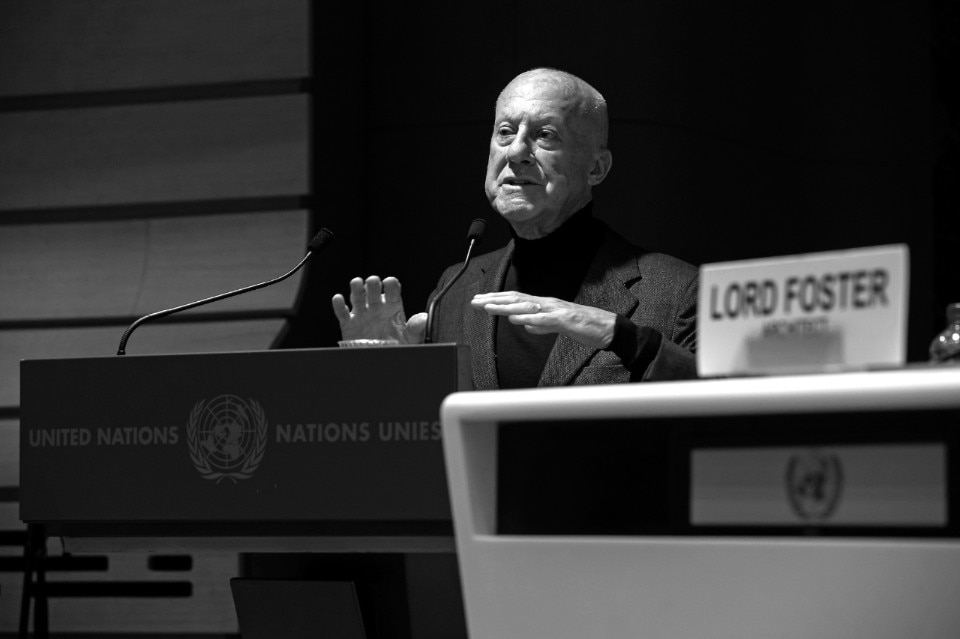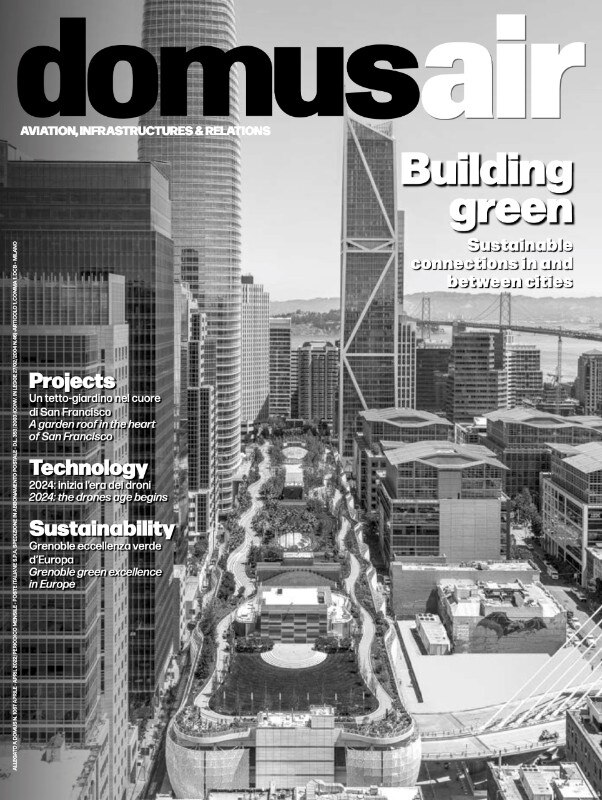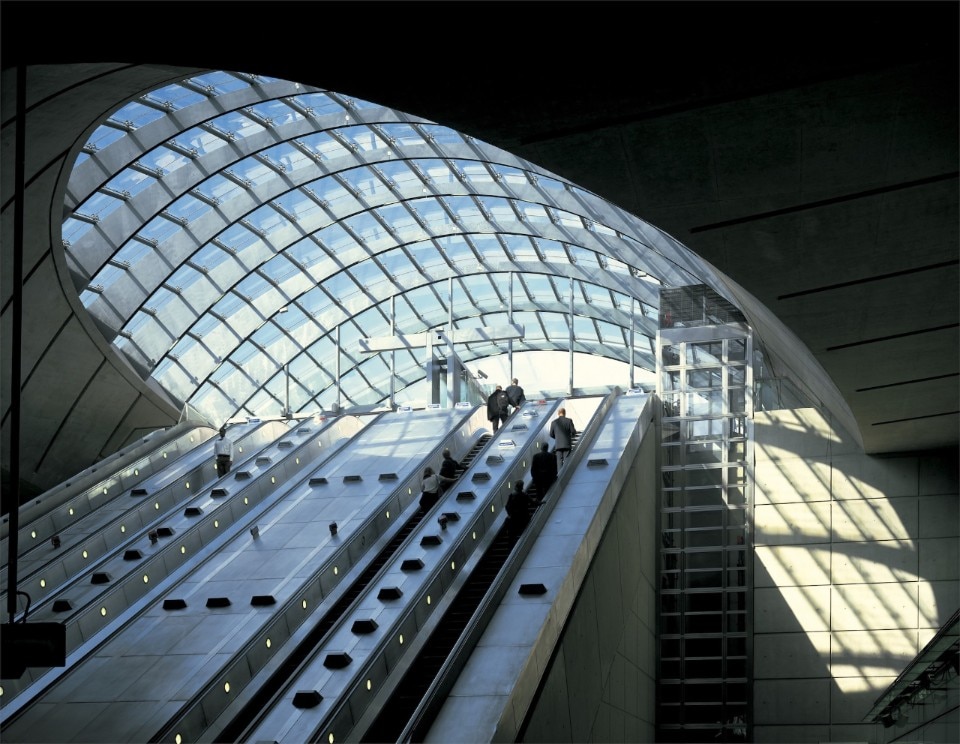This article was originally published on DomusAir n.4, April 2022.
Paola Deda: If anyone was to ask me how I first met Norman Foster and how that led to him working closely with the United Nations, there is a simple, if somewhat unexpected, answer – a newspaper article. It was 24 September 2020 and I had spent the day tweaking the latest logistical aspects of the very first UN Forum of Mayors, a gathering of city leaders to discuss how they were managing to make cities more sustainable while struggling to contain the COVID-19 emergency. Consumed with anticipation for the event, I did not get much sleep that night and decided, in the early hours of the morning, to browse through the news via my smartphone. Scanning the UK’s Guardian newspaper online, I spotted an article written by Norman Foster on cities and the pandemic. From my university days, I had admired his ability to marry technology and beauty so effortlessly and to turn every single one of his structures into urban landmarks. Enthused, I read on.
“Cities are the future ... and will have the potential to be quieter, cleaner, safer, healthier, more friendly, walkable and bikeable and vitally, if the opportunity is grasped, to be greener”, Norman had written. I repeated that key, qualifying condition to myself “If the opportunity is grasped”. His article was so aligned with my own vision and hopes for the messages that the UN Forum of Mayors would convey. Norman saw the pandemic not so much as an initiator of change but as an accelerating force of trends that already existed. He talked about new working and mobility patterns that, if used strategically, would help the transition to more sustainable cities. “The hope is a better balance - shared global action on the big environmental and health issues, and local action in the making, growing and powering of our connected societies”. But, to repeat that crucial mantra one more time, only “if the opportunity is grasped”. I began to churn ideas in my head. How can we intertwine local and global thinking, translating national commitments into practical action at the city level? How can we empower a local voice inform the global debate, exchange ideas and solutions, and shake hands? How can we grasp the opportunities that Norman was writing about? To each of these questions there was only one answer -
Norman was needed at our event. He had to address the meeting and talk to mayors and national diplomats about the opportunities to grasp. And Norman did. On 6 October 2020, architect Norman Foster headed out the First Forum of Mayors at the United Nations in Geneva, giving an opening address to the mayors who had made it in person in the “Emirates Room”, a beautifully designed futuristic space quite fit for the purpose, as well as many other mayors and hundreds of participants online.
Norman Foster: The day my article was published. I was travelling on projects and Paola called the central number at my practice headquarters in London. A message was swiftly conveyed to me that a lady from the UN had read my Guardian piece and needed my help, urgently. The moment I was able to, I returned Paola’s call and was immediately, I as have been ever since, moved by her enthusiasm in so many areas where we share the same views. We had never met but we quickly realised that, at the heart of what we both believe, there is an unwavering commitment to cities and civic leadership in ensuring our planet’s sustainable future. Her request to me was to go to Geneva at short notice and convey in person exactly what I had written in the Guardian, to the civic leaders that would be gathered there. I was impressed with her plans and I accepted without hesitation.

P.D.: Although I trained as an architect, my life trajectory differed greatly from Norman’s, yet our convictions converge when it comes to opportunities that can make the United Nations, cities and architects work together in shaping global solutions for a sustainable future. We have both long recognised that in a progressively complex world, more connected but also more intricate, diplomacy needs to expand to embrace the contribution of local actors.
The idea behind city diplomacy is to support the existing trend which has led to the formation of city alliances and networks to enable an enhanced voice of local governments at an international level, whilst simultaneously allowing cities to bring their own direct experience to those with a global influence. Cities should work with national governments in a “better balance” where “shared global action on the big environmental and health issues” go hand in hand with “local action in the making, growing and powering of our connected societies”. Alliances are essential, not least when geographical footprint may have, previously, been a restricting factor. Take, for instance, small island countries in the context of the United Nations. It is through their Small Islands Developing States (SIDS) grouping, and the related Alliance of Small Island States (AoSIS), that they have managed to become critical players in major world negotiations, such as those on climate. Not only have they brought their challenges to the attention of the world stage - such as rising sea levels, devastating weather events, coastal erosion and loss of marine biodiverse coral reefs - they continue to be players and referees in the complicated game of international politics and diplomacy that shapes decisions affecting all nations.
Foster saw the pandemic not so much as an initiator of change but as an accelerating force of trends that already existed
However, whilst island countries are well represented by their grouping, they are foremost individual UN members. Not only with their sovereign rights and national identities, but also with their specific needs and individual contributions to the international architecture. When it comes to cities and the role they play in international diplomacy, alliances and networks are equally strategic. They allow cities to grasp opportunities. Take the network C40, for instance. Its 97 member cities, collectively comprising one quarter of global GDP, are an extremely influential voice when it comes to fighting climate change, making commendable commitments and taking actions that echo loudly in the corridors during UN negotiations. Then again there is UCLG (United Cities and Local Governments), which has an increasingly recognised role in UN gatherings by engaging, directly and indirectly, over 240,000 local governments, and “giving” a voice to over 70 per cent of the global population, to mention another strategic network. It is not only politically complex, but also physically impossible, to gather representatives from every world city in the same assembly hall but that doesn’t hamper ambitions of both local and national governments.
The UN Forum of Mayors is pioneering the integration of the voices of individual cities within the work of intergovernmental processes at the UN. We are looking forward to seeing how it will function in the future. It will take time and the wisdom of national diplomats and intergovernmental dialogue to create a formula for city participation in the international arena that could work effectively and be politically acceptable and sound. The new formula will indeed be an opportunity grasped, and a step towards a “better balance” between the local needs of citizens and the decisions of governments. For this we also need a more holistic vision of what an architect should be, to support the transition of the world and cities to a new era of balance. The modern world has separated many roles and functions, making thinkers and philosophers the intellectuals using words as their medium, while architects are perceived only as visual actors using design as a means to shape forms, but not thoughts or ideals.
Architects need to reclaim the role that the Renaissance afforded them as visual thinkers, and continue changing not only spaces, but also perceptions, habits, organisational behaviour, and even minds and moods, through acknowledgement of their structures and designs as influences on cities and their inhabitants.

N.F.: With a city diplomacy role comes responsibilities that have been at the heart of my professional practice for over five decades. Architects have to be true ambassadors of sustainability. For their legacy to be worthwhile, they need to have a light touch on the planet. They need to understand nature as much as the mechanics of materials. They need to design so that their buildings, and the infrastructure that binds them to create cities, recirculate to avoid waste, save energy, and are flexible and adaptable to change. The ultimately sustainable building is one that can be recycled rather than demolished. On the other hand, cities need to respond to growth, to keep compact and reduce unsustainable sprawl.
The imperative then may be to demolish and build more densely. Architects need to continually embrace new technologies and challenge old ones. They have to adapt to evolving needs of new generations or developing nations. Architecture has to work with nature and architects should strive to integrate it, understand it and explain it.
That burden of responsibility means that the architect must become an advocate of city diplomacy – negotiating between the needs of those who commission and those that they serve or influence. Architects as city diplomats already have many of the tools to invoke their specific brand of advocacy – they just need to use them. They must be ready to support the transformation of parking lots into urban orchards, of streets too narrow for cars into avenues for bicycles and pedestrians, of open spaces and urban farming, maybe layered vertically, old train tracks into green corridors for new forms of mobility. Our ever growing connectivity through technology must be used to make spaces and cities smarter for people, and to create homes that make dwellers feel comfortable and dignified - no matter what their social status – and, outside of their homes, we need to grow the environments where people can meet and talk – to never feel lonely again. To rediscover and enhance the civic realm. At the beginning of COP 26 in Glasgow, the UN organised a breakfast conversation between John Kerry – the US Special Presidential Envoy for Climate – and myself, moderated by the Leader of Glasgow’s City Council. There were two audiences – the mayors in the room from all over the world and those online. I only realised afterwards the power of advocacy and the role of the UN, when told that our conversation reached an audience of well over a billion.
P.D.: In his Guardian article Norman was convinced that the pandemic would accelerate positive trends in cities; with this article we wanted to also share our conviction that the United Nations could accelerate many positive trends in cities. As could architects, if the opportunity is grasped.

Opening image: Foster + Partners, Canary Wharf Underground Station, London, United Kingdom, 1999. Photo Nigel Young


